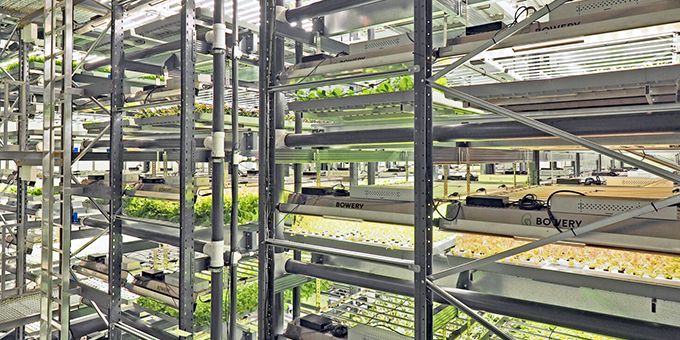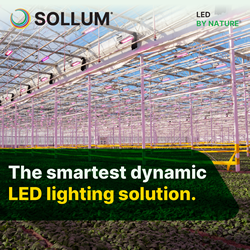A climate-controlled environment allows for year-round, reliable food production. This reliability means the consumer has access to fresh, locally grown produce in every season.
 Vertical Farming Advantages You Should Know About
Vertical Farming Advantages You Should Know About

Article from | Bowery Farming
Vertical farming harnesses the power of technology to grow crops efficiently (stacked one on top of the other) in a controlled environment. This unlocks many positives, such as higher productivity per square foot, a more efficient use of resources, and a reliable yield 24/7 (one of the main challenges of traditional field farming outdoors). Vertical farms can also be built anywhere and are typically located outside of cities, so that fresher produce can hit shelves at local grocery stores and cut down food miles.
Growing up instead of out is an important element of the future of sustainable food production. Here are six advantages of vertical farming you should know about.
What is Vertical Farming?
Vertical farming is the process of growing crops vertically to maximize space, usually in a controlled indoor environment. This method results in high crop yields, allows for year-round food production in any climate, and enables farms to focus on goals ranging from food safety to quality.
The Advantages of Vertical Farming
The indoor vertical farming method involves growing crops in vertical layers to conserve space. Soilless growing techniques like hydroponic farming are key to the success of vertical farms.The combination of technology and a controlled indoor growing environment optimizes plant growth, health, flavor, and yield.
Here’s a look at the advantages of vertical farming every consumer should be aware of:
Year-Round Food Production
Indoor vertical farms can grow 365 days per year, regardless of the weather conditions. Vertical farms are not susceptible to the impacts of storms or extreme weather events in the way conventional farms are.
A climate-controlled environment allows for year-round, reliable food production. This reliability means the consumer has access to fresh, locally grown produce in every season.

Efficient Use of Space
Vertical farming allows our farmers to grow more food in less space than traditional farming in horizontal rows. Vertical farms can also be built in any location, regardless of soil quality.
Anything from an abandoned warehouse to a storage facility or shipping container right in the city can be turned into a vertical farm. Because the crops are stacked, Bowery’s vertical farms are 100 times more productive on the same footprint of land than a traditional farm.
This means produce can be grown closer to population centers, even in locations where suitable farmland isn’t available. Repurposing former industrial buildings into vertical farms has the potential to save forests being cleared to create more farmland.
Sustainable Practices
Vertical farming utilizes an approach that respects the environment and focuses on sustainable practices. By growing crops close to cities, vertical farms reduce both food miles (how far food travels to reach the shelf) and food waste that is common to long-haul transport.
Vertical farming also allows for enhanced resource management. Water can be recaptured and recycled; a single Bowery farm saves 15-20MM gallons of water a year compared to traditional agriculture.
Although vertical farms require energy to pump water and nutrients and provide artificial lighting for the plants, much of the environmental impact and cost can be mitigated with strategies like thermal insulation and the use of renewable energy from sources like solar and low-impact hydro. At Bowery, we’re committed to growing with renewable energy—our Maryland farm and New Jersey farms run on 100% low impact renewable energy, which means we avoid using 30MM lbs of CO2 annually. We plan to power all of our future farms with renewable energy, too.
Vertical farming, as we practice it, is free of pesticides and herbicides and eliminates fertilizer runoff, which can be harmful to the local water supply, plant life, and wildlife.
Food Grown Close to Cities
By repurposing industrial buildings into smart indoor vertical farming systems, food can be grown closer to the cities where it is consumed.
Growing produce closer to the market where consumers shop eliminates food miles and food waste, shortening the time between harvest and when produce reaches the shelf.
Removing long-haul shipping from the equation also allows farms like Bowery to focus on seeds selected for quality and flavor, rather than durability and storability. That’s another win for the consumer!
Safe Food Production
Another advantage of vertical farming is safe food production. Since 2010, leafy greens have been involved in 15 multi-state E. coli outbreaks. This makes food safety a major concern for consumers. These outbreaks are often due to black water runoff and irrigation water contamination from nearby livestock farms. Tracing the origins of each outbreak is challenging because crops often come from a variety of farms, are mixed at processing plants, and distributed by a third party.
This makes food safety a major concern for consumers. These outbreaks are often due to black water runoff and irrigation water contamination from nearby livestock farms. Tracing the origins of each outbreak is challenging because crops often come from a variety of farms, are mixed at processing plants, and distributed by a third party.
Bowery’s indoor vertical farms eliminate the risk of runoff contamination. We also take the extra step of filtering our irrigation water for safety, and since we control every aspect of the journey from seed to store, the vulnerability to outbreaks is greatly reduced. Were an issue to occur that would require deeper investigation, we have the technology in place to source and rectify the problem much faster and more efficiently than a traditional farm.
Our self-contained, fully traceable food supply chain is designed to give consumers peace of mind.
How We’re Making the Most of Vertical Farming at Bowery
Our vertical farms are a form of Controlled Environment Agriculture (CEA), and they use technology and innovation to provide the best product possible for our customers. Our vertical farms place crops in rows stacked on top of each other in a contained warehouse environment for maximum crop health and yield.
 Growing in a controlled environment allows us to manipulate and control the growing conditions of each specific type of plant. Much like the smart systems in your home, agriculture technology is used to regulate the lighting, temperature, humidity, and nutrients provided to each area of our indoor vertical farming areas.
Growing in a controlled environment allows us to manipulate and control the growing conditions of each specific type of plant. Much like the smart systems in your home, agriculture technology is used to regulate the lighting, temperature, humidity, and nutrients provided to each area of our indoor vertical farming areas.
With this strategy, we can grow multiple types of produce in one indoor farm while providing the best growing conditions for each crop’s individual needs. Automation allows Bowery to provide an ideal growing environment at scale.
The Bowery operating system (Bowery OS) tracks every crop that’s growing in our farms, from the time the seed is planted until harvest. The Bowery OS tells our modern farmers how many days it takes for the seed to germinate, when the plant should be moved to the grow room, and when it’s ready for harvest.
Why the Future of Agriculture and Food Production Are So Important
By the year 2050, the world’s population is expected to exceed 9 billion people. With our growing global population, food security and sustainable food production have never been more important.
Not only that but industrial development and high-population density urban areas are constantly expanding, which means there’s less and less arable land available for farming. In fact, scientists believe that the Earth has already lost more than a third of its arable land just in the last 40 years.
No one knows how much farmland we will lose by 2050 and beyond, so maximizing food production in the smallest amount of space possible is crucial. Vertical farming could be the answer to sustainable agriculture and healthy food production as our population grows and natural resources become more limited.
Climate change could also become an issue for traditional farms. At Bowery, we’re already developing and implementing technological solutions into our indoor farming systems that will address many of the key issues humans will be facing in the future.
Is Vertical Farming Better Than Traditional Farming?
In order to feed our growing population, we need solutions beyond traditional farming. Vertical farming is efficient and reliable, producing more food per square foot than traditional farms.
Traditional farming methods require massive inputs of organic and inorganic fertilizers to maintain soil health and maximize crop production. The plants are also vulnerable to pests, disease, and adverse weather conditions, requiring additional chemical inputs.
Vertical farms grow crops without soil. Water and nutrients are recirculated to the plant roots multiple times, so there’s no waste or runoff. Since the environment is self-contained, it’s not affected by weather conditions.
That being said, the output from vertical farms alone won’t be enough to feed our rapidly growing population. Conventional farmers, modern farmers, and agricultural scientists will need to work together to create a more resilient, sustainable food system for our growing global population.
Wrapping Up: The Future of Indoor Vertical Farming at Bowery
At Bowery, our agricultural scientists continue to research what’s beyond herbs and leafy greens to diversify potential output from our vertical farms in the near future. Our systems-based approach allows us to collect and analyze historical data so we can optimize growing conditions going forward.
We’ve accumulated metrics from thousands of growing cycles, including humidity, airflow, CO2 emissions, light intensity, and more. This will help us to maximize food production while conserving resources and reducing energy consumption even further in the future.
Indoor vertical farming provides unique solutions for many of the problems we’re facing to feed a growing world population with fewer resources. By developing and implementing these strategies now, we can get ahead of many of these issues and contribute to a more sustainable food system for all.

The content & opinions in this article are the author’s and do not necessarily represent the views of AgriTechTomorrow
Comments (0)
This post does not have any comments. Be the first to leave a comment below.
Featured Product

